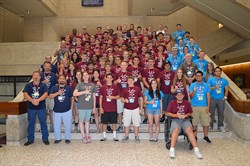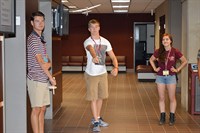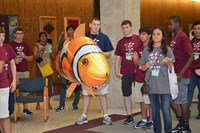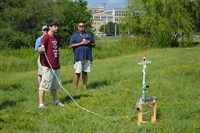 Camp SOAR (Summer Opportunities in Aerospace Research) 2014 was hosted by the Department of Aerospace Engineering with the help of The Boeing Company and Rockwell Collins July 20-25, 2014.
Camp SOAR (Summer Opportunities in Aerospace Research) 2014 was hosted by the Department of Aerospace Engineering with the help of The Boeing Company and Rockwell Collins July 20-25, 2014.
Camp SOAR is a five-day summer camp designed to expose upcoming high school juniors and seniors with an interest in aerospace engineering to the research and facilities at Texas A&M University’s (TAMU) Department of Aerospace Engineering (AERO). Sixty students, twice as many as the previous years, were selected from applications across the nation to explore the field of aerospace engineering with an emphasis on either airplanes, rockets or airships.
The students began the week with a lecture on “What is AERO?,” an introduction by the lead professors. The students were given a brief history of aerospace engineering and the multiple aerospace programs in operation today. With their individual questions, they can explore the various career paths available to them.
Students involved in the Airplanes track started with airplane fundamentals and a short lecture defining aerodynamic lift by Wayne Lutz, Camp SOAR instructor and Lecturer in the Department of Aerospace Engineering. Students were introduced to basic definitions of aerodynamics and followed Lutz’s explanation on how an airplane wing produces forces to lift an airplane aloft.
 The Airplane students were then introduced to basic airplane flight control fundamentals through the paper airplane project. Using paper airplane models, the students folded a unique paper design into a paper glider. They then competed with fellow students to achieve best glide distance and accuracy. Lutz offered real-time suggestions on their design to improve the airplane performance. The students enjoyed the fun first-day activity visualizing airplane aerodynamics.
The Airplane students were then introduced to basic airplane flight control fundamentals through the paper airplane project. Using paper airplane models, the students folded a unique paper design into a paper glider. They then competed with fellow students to achieve best glide distance and accuracy. Lutz offered real-time suggestions on their design to improve the airplane performance. The students enjoyed the fun first-day activity visualizing airplane aerodynamics.
The Rocket and Space track, led by Dave Kanipe, Camp SOAR instructor and Lecturer in the Department of Aerospace Engineering, is designed to provide the students with the fundamentals of physics of how rockets work and what it takes to get to space and orbit the earth. Actual classroom lectures were minimal and kept as short as possible. In addition, a number of short videos of space-related subjects were utilized to maintain student interest and provide inspiration.
The Rocket track students engaged in the fun activity of making and flying their own rockets. They used compressed air powered rockets, as it is relatively easy for the students to understand the basic physics behind their flight. This also gave the students the ability to launch the rockets several times, which game them multiple opportunities to observe their rocket and understand its motion. During the week, the students competed amongst themselves for distance and accuracy.
At the start of the Airships track, the students were given a brief introduction on the fundamentals of buoyant flight and its history by Zach Harris and Divya Sri Praturi, Camp SOAR instructors and graduate students in the Department of Aerospace Engineering. As a fun, small scale warm-up activity, each student constructed a hot air balloon using trash bags, straw and candles. This activity reinforced the concepts reviewed in the airship fundamentals presentation, especially the necessity of a higher buoyant force than weight force, and provided the students with the opportunity to practice the engineering concepts related to design, testing and redesign.
 For the remainder of the week, the Airship track students worked on developing autonomous Air Swimmers and optimizing them to meet the given requirements. Air Swimmers are helium-filled balloons that are propelled by flapping tails; thus the students’ first task was to design and test two tail shapes. Following the selection of a tail, the students were provided the necessary hardware, software, and instruction to fully automate their Air Swimmers. During this phase, they conducted tests to determine the optimal power and timing settings for the tail.
For the remainder of the week, the Airship track students worked on developing autonomous Air Swimmers and optimizing them to meet the given requirements. Air Swimmers are helium-filled balloons that are propelled by flapping tails; thus the students’ first task was to design and test two tail shapes. Following the selection of a tail, the students were provided the necessary hardware, software, and instruction to fully automate their Air Swimmers. During this phase, they conducted tests to determine the optimal power and timing settings for the tail.
During the week, all of the students toured the department’s facilities, including, but not limited to the Vehicle and Systems Control Laboratory, Land Air and Space Robotics Lab, the Oran Nicks Low Speed Wind Tunnel, and many more. In the Flight Research Laboratory they were each given the opportunity to test their skills on the flight simulator. As part of their exposure to aerospace propulsion systems, all students had the opportunity to observe and operate a small firing jet engine. During the lab tours and throughout the week, the students were given the opportunity to interact with current students as well as world-renowned faculty.
The campers stayed on campus and had use of the University’s recreational facilities, the University library and the University’s computer facilities and had the chance to see what it is like to live the life of a student at Texas A&M.
 At the conclusion of the week, the students teamed up to compete with their final projects. The Airplane and Rocket tracks combined to launch a small balsa wood glider attached to a rocket. The students split into teams of two: one rocket team member and one airplane team member. Working together, the goal was that the rocket must deliver the glider to as high an altitude as possible and the airplane must glide for as long as possible. For the Airships track, the culmination of the Air Swimmers project was a fly-off in the lobby of the Zachry building. Each team of students competed to fly the given path in the shortest amount of time.
At the conclusion of the week, the students teamed up to compete with their final projects. The Airplane and Rocket tracks combined to launch a small balsa wood glider attached to a rocket. The students split into teams of two: one rocket team member and one airplane team member. Working together, the goal was that the rocket must deliver the glider to as high an altitude as possible and the airplane must glide for as long as possible. For the Airships track, the culmination of the Air Swimmers project was a fly-off in the lobby of the Zachry building. Each team of students competed to fly the given path in the shortest amount of time.
The Boeing Company recognizes the value this program provides high schools students interested in learning more about aerospace engineering and was pleased to provide monetary and personnel support for the program, including the sponsorship of scholarships. This is the first year Rockwell Collins provided monetary support to Camp SOAR as they also recognize the value of the program.